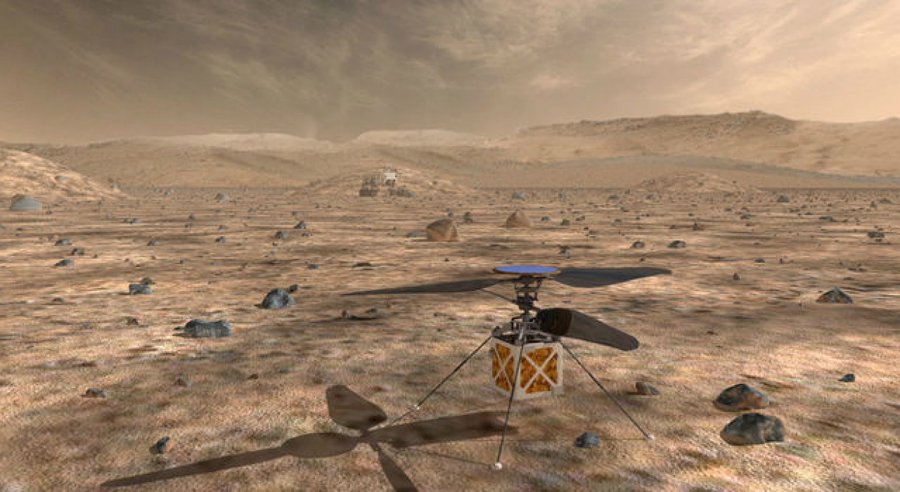Small Helicopter Will Travel To Red Planet With Mars 2020 Rover Mission
A small, autonomous rotorcraft – the Mars Helicopter – will travel with NASA’s Next Red Planet Rover Mission.
The mission is scheduled to launch in July 2020, to demonstrate the viability and potential of heavier-than-air vehicles on the Red Planet.
“The Mars Helicopter” is weighing less than (four pounds) 1.8 kilograms); its fuselage is about the size of a softball, and its twin, counter-rotating blades will bite into the thin Martian atmosphere at almost 3,000 rpm – about 10 times the rate of a helicopter on Earth.
“NASA has a proud history of firsts,” said NASA Administrator Jim Bridenstine.
“The idea of a helicopter flying the skies of another planet is thrilling. The Mars Helicopter holds much promise for our future science, discovery, and exploration missions to Mars.”
The project started in 2013 at NASA’s Jet Propulsion Laboratory (JPL), and the team’s four-year-long work resulted in this very small device that will be attached to the belly pan of the Mars 2020 rover.

NASA’s Mars Helicopter, a small, autonomous rotorcraft, will travel with the agency’s Mars 2020 rover, currently scheduled to launch in July 2020, to demonstrate the viability and potential of heavier-than-air vehicles on the Red Planet. Credits: NASA/JPL-Caltech
“The altitude record for a helicopter flying here on Earth is about 40,000 feet (12,100 meters)”.
The atmosphere of Mars is only one percent that of Earth, so when our helicopter is on the Martian surface, it’s already at the Earth equivalent of 100,000 feet (30,500 meters) up, ” said Mimi Aung, Mars Helicopter project manager at JPL.
“To make it fly at that low atmospheric density, we had to scrutinize everything, make it as light as possible while being as strong and as powerful as it can possibly be.”
Once the rover is on the planet’s surface, a suitable location will be found to deploy the helicopter down from the vehicle and place it onto the ground.
The rover then will be driven away from the helicopter to a safe distance from which it will relay commands. After its batteries are charged and a myriad of tests are performed, controllers on Earth will command the Mars Helicopter to take its first autonomous flight into history.
“We don’t have a pilot and Earth will be several light minutes away, so there is no way to joystick this mission in real time,” said Aung.
“Instead, we have an autonomous capability that will be able to receive and interpret commands from the ground, and then fly the mission on its own.”
The full 30-day flight test campaign will include up to five flights of incrementally farther flight distances, up to a few hundred meters, and longer durations as long as 90 seconds, over a period. On its first flight, the helicopter will make a short vertical climb to 10 feet (3 meters), where it will hover for about 30 seconds.
As a technology demonstration, the Mars Helicopter is considered a high-risk, high-reward project.
If it does not work, the Mars 2020 mission will not be impacted. If it does work, helicopters may have a real future as low-flying scouts and aerial vehicles to access locations not reachable by ground travel.
Original story



 Creators of mankind
Creators of mankind Description of “Tall white aliens”
Description of “Tall white aliens” Where they came from?
Where they came from? About hostile civilizations
About hostile civilizations The war for the Earth
The war for the Earth “Tall white aliens” about eternal life
“Tall white aliens” about eternal life Video: “Nordic aliens”
Video: “Nordic aliens” Aliens
Aliens Alien encounters
Alien encounters The aliens base
The aliens base UFO
UFO Technology UFO
Technology UFO Underground civilization
Underground civilization Ancient alien artifacts
Ancient alien artifacts Military and UFO
Military and UFO Mysteries and hypotheses
Mysteries and hypotheses Scientific facts
Scientific facts


















